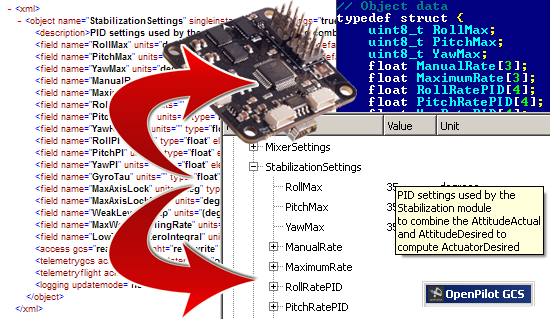| Section | ||||||||||||||||
|---|---|---|---|---|---|---|---|---|---|---|---|---|---|---|---|---|
|
Creating UAVObjects
The source code for UAVObjects is automatically generated for both the ground and flight software using the UAVObjectGenerator command line utility, this utility reads an XML definition of the object and its fields and generates the necessary autopilot and GCS source code.
UAVObjectGenerator Utility
The source code for the UAVObjectGenerator can be found at ground\uavobjgenerator, the most straight forward way to compile this source is by building it on the command line, all you need is a working Qt environment. For example, do this by performing the following:
...
| Code Block | ||||
|---|---|---|---|---|
| ||||
make uavobjects |
XML File
The next step is to create the UAVObject definition file. All definition files are located in the shared\uavobjectdefinition directory. Each XML file defines at least a single object. An example file is shown below.
| Code Block | ||||
|---|---|---|---|---|
| ||||
<xml>
<object name="GPSPositionSensor" singleinstance="true" settings="false" category="Sensors">
<description>Raw GPS data from @ref GPSModule.</description>
<field name="Status" units="" type="enum" elements="1" options="NoGPS,NoFix,Fix2D,Fix3D"/>
<field name="Latitude" units="degrees x 10^-7" type="int32" elements="1"/>
<field name="Longitude" units="degrees x 10^-7" type="int32" elements="1"/>
<field name="Altitude" units="meters" type="float" elements="1"/>
<field name="GeoidSeparation" units="meters" type="float" elements="1"/>
<field name="Heading" units="degrees" type="float" elements="1"/>
<field name="Groundspeed" units="m/s" type="float" elements="1"/>
<field name="Satellites" units="" type="int8" elements="1"/>
<field name="PDOP" units="" type="float" elements="1"/>
<field name="HDOP" units="" type="float" elements="1"/>
<field name="VDOP" units="" type="float" elements="1"/>
<field name="SensorType" units="" type="enum" elements="1"
options="Unknown,NMEA,UBX,UBX7,UBX8" defaultvalue="Unknown" />
<field name="AutoConfigStatus" units="" type="enum" elements="1"
options="DISABLED,RUNNING,DONE,ERROR" defaultvalue="DISABLED" />
<field name="BaudRate" units="" type="enum" elements="1"
options="2400,4800,9600,19200,38400,57600,115200,230400,Unknown"
defaultvalue="Unknown" />
<access gcs="readwrite" flight="readwrite"/>
<telemetrygcs acked="false" updatemode="manual" period="0"/>
<telemetryflight acked="false" updatemode="periodic" period="1000"/>
<logging updatemode="manual" period="0"/>
</object>
</xml> |
Object attributes
The object attributes define the name and type of the object.
...
The telemetrygcs and telemetryflight entries are used by the telemetry modules. The acked attribute defines if object transactions should be acknowledged. The updatemode can be one of the following: periodic, onchange, manual and never. The periodic mode will send the object through the telemetry link at the interval defined in the period attribute (in ms). The onchange mode will send the object through the telemetry link only when it changes, care must be taken when this mode is used in frequently updated objects. In the manual mode the object will only be updated when requested remotely or locally.
Adding Your Object to the Build
Once the object definition file is created and copied in the shared\uavobjectdefinition directory and UAVObjectGenerator should be invoked with no arguments. The generator will process all XML files and generate the output files in the following directories, ground\uavobjects for the ground code and flight\UAVObjects for the flight code.
...
Rebuild, reload and now you should be able to see the newly created object in the GCS UAVObject browser.
